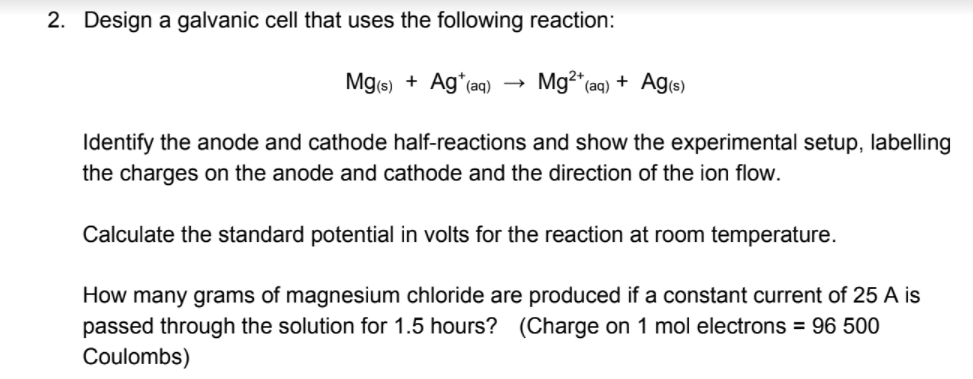2. Design a galvanic cell that uses the following reaction: Mge) + Agʻ(aq) Mg" (aq) + Ag(s) Identify the anode and cathode half-reactions and show the experimental setup, labelling the charges on the anode and cathode and the direction of the ion flow. Calculate the standard potential in volts for the reaction at room temperature. How many grams of magnesium chloride are produced if a constant current of 25 A is passed through the solution for 1.5 hours? (Charge on 1 mol electrons = 96 500 Coulombs)
2. Design a galvanic cell that uses the following reaction: Mge) + Agʻ(aq) Mg" (aq) + Ag(s) Identify the anode and cathode half-reactions and show the experimental setup, labelling the charges on the anode and cathode and the direction of the ion flow. Calculate the standard potential in volts for the reaction at room temperature. How many grams of magnesium chloride are produced if a constant current of 25 A is passed through the solution for 1.5 hours? (Charge on 1 mol electrons = 96 500 Coulombs)
Chemistry & Chemical Reactivity
10th Edition
ISBN:9781337399074
Author:John C. Kotz, Paul M. Treichel, John Townsend, David Treichel
Publisher:John C. Kotz, Paul M. Treichel, John Townsend, David Treichel
Chapter19: Principles Of Chemical Reactivity: Electron Transfer Reactions
Section: Chapter Questions
Problem 84GQ
Related questions
Question

Transcribed Image Text:2. Design a galvanic cell that uses the following reaction:
Mg(s) + Ag*(aq)
Mg2 aq) + Ag(s)
Identify the anode and cathode half-reactions and show the experimental setup, labelling
the charges on the anode and cathode and the direction of the ion flow.
Calculate the standard potential in volts for the reaction at room temperature.
How many grams of magnesium chloride are produced if a constant current of 25 A is
passed through the solution for 1.5 hours? (Charge on 1 mol electrons = 96 500
Coulombs)
Expert Solution
This question has been solved!
Explore an expertly crafted, step-by-step solution for a thorough understanding of key concepts.
Step by step
Solved in 3 steps with 3 images

Knowledge Booster
Learn more about
Need a deep-dive on the concept behind this application? Look no further. Learn more about this topic, chemistry and related others by exploring similar questions and additional content below.Recommended textbooks for you

Chemistry & Chemical Reactivity
Chemistry
ISBN:
9781337399074
Author:
John C. Kotz, Paul M. Treichel, John Townsend, David Treichel
Publisher:
Cengage Learning

Chemistry & Chemical Reactivity
Chemistry
ISBN:
9781133949640
Author:
John C. Kotz, Paul M. Treichel, John Townsend, David Treichel
Publisher:
Cengage Learning


Chemistry & Chemical Reactivity
Chemistry
ISBN:
9781337399074
Author:
John C. Kotz, Paul M. Treichel, John Townsend, David Treichel
Publisher:
Cengage Learning

Chemistry & Chemical Reactivity
Chemistry
ISBN:
9781133949640
Author:
John C. Kotz, Paul M. Treichel, John Townsend, David Treichel
Publisher:
Cengage Learning


Principles of Modern Chemistry
Chemistry
ISBN:
9781305079113
Author:
David W. Oxtoby, H. Pat Gillis, Laurie J. Butler
Publisher:
Cengage Learning

Chemistry
Chemistry
ISBN:
9781305957404
Author:
Steven S. Zumdahl, Susan A. Zumdahl, Donald J. DeCoste
Publisher:
Cengage Learning

Chemistry: Principles and Practice
Chemistry
ISBN:
9780534420123
Author:
Daniel L. Reger, Scott R. Goode, David W. Ball, Edward Mercer
Publisher:
Cengage Learning